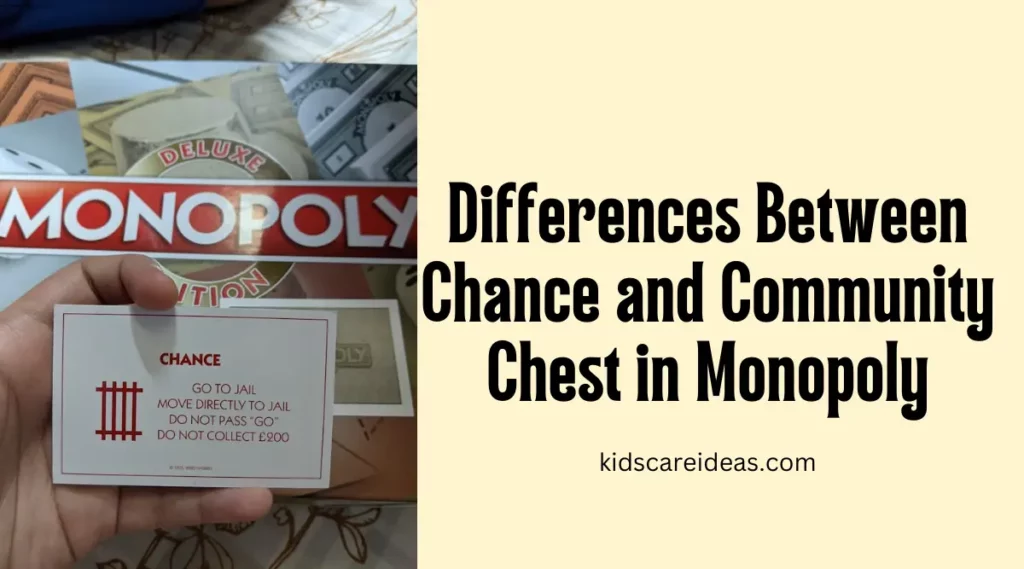Community Chest cards and chance cards are two unique gaming cards in Monopoly. A player has to draw these cards when they land on any corresponding space over the monopoly board. Drawing these cards can reward, move, or punish the player.
Both these cards are not the same, they are very much different. In this article, I have covered their differences fully, so that you understand it well.

What are Chance and Community Chest Cards in Monopoly?
The name of the chance cards is very relevant to the action it performs that is chance-based. Let us understand how.
There are 16 different variants of chance cards on the Monopoly board. A player would be lucky if they draw a chance card instructing them to move to an unowned property.
On the other hand, if they draw a chance card instructing them to move towards a previously owned property, that is a sheer misfortune for the player.
Community Chest card also draws its name from a very relevant source, that is, the Atlantic City community chest in Monopoly. There are 16 Chance cards in the game.
The idea of this chest is to gather funds for the community and help the underprivileged with the money. Though this term is no more in practical use in the US society, it is still used on the board of Monopoly.
These cards are intended for communal generosity, giving the players some perks.
They are friendly cards through which the player community helps players by either boosting them with some funds from a bank or setting them free from jail.
Differences Between Chance and Community Chest Cards
As already described, chance cards are chance-based and can move the player to any particular position – toward an unowned property or one owned by other players.
This might or might not benefit the player in the game, hence the name chance cards. Here are some chance card variants on the Monopoly board:
- Card 7 will direct the player toward a Utility property or a railroad. There is a chance of 44% movement with this card.
- Card 3 has a 19% chance of making the player pay money to the bank.
- Card 2 rewards the players with cash with a 13% chance
- With a 6% chance on the go, card 1 can get you out of jail.
- Card 1 can also make a player move back to three important spaces on the board – New York Avenue, Community Chest, or Income Tax
On the other hand, community chest cards are helpful and rewarding for the players.
They will most likely have a positive outcome for the player. Here are some of the variants of the Community Chest cards and how they influence the movement of the players on board.
- Card 9 rewards the player with cash. There are 56% chance of this reward
- Card 4 has a 26% chance of making the player pay money to the bank
- Card 1, similar to the Chance cards, has a 6% chance of making the player either go to jail or get out of jail
- Card 1 for Advance to Go
Chance and Community Chest cards also look different visually. Community chest cards are blue, while chance cards are orange.
How many Chance and Community Chest spaces are on a Monopoly board?
Chance and Community Chest cards have three spaces each on a classic Monopoly board. Usually, the third side of the Monopoly board features a Chance space, while the second has a Community Chest space.
These spaces can be spotted on the first (demarcated by Light blue and brown color) and the last (Dark Blue and Green) sides of the Monopoly board.
Considering the total number of spaces on board to be 40, each player has a 6.66% chance of landing on either a Community chest or Chance space.
Indiana Avenue is the only space on board devoid of chance and community spaces.
How many Chance Cards and Community Chest Cards are in the Monopoly Board Game?
There are 16 Chance Cards in the Monopoly game. Also, there are 16 Community chest cards in the Monopoly Game.
Can Community Chest send you to Jail?
Yes. The Community Chest card deck has one card labeled “Go Directly to Jail.” If a player draws this card, they will directly go to the jail.
Also, with this action, the player’s turn in the game ends, and they cannot even opt for any Passing Go bonus.
Not only Community Chest cards, but the Chance Card deck also has a Go to Jail card with similar action outcomes.
Here lies the irony – the general conception is that Community Chest cards always have a positive outcome. But with this Go to Jail card, the picture is different.
Are Chance cards optional?
No, they are not. Chance cards are not optional on the Monopoly board. If a player lands on a Chance space, the player must follow whatever instructions come with the card.
It is mandatory to follow the actions mentioned on the Chance card. However, there are always certain deviations in rules regarding Chance cards in Monopoly.
The house rules make it possible. Chance cards can unofficially be treated as an optional move under the provisions of House rules but never officially.
Where does Chance and Community Chest money go?
The money goes to the bank. When a player has to pay the funds based on instructions on the Chance and Community Chest cards, the money does not go to any player or any free parking.
Instead, the money goes to the bank to add to the fund.
Some players believe that chance and community money should go into the free parking space at the center of the board, but currently, that does not operate because the game survives on the circulation of money through the bank.
What are the best Chance and Community Chest cards to get in Monopoly?
Both community chest cards and chance cards have their unique set of pros and cons. None of them can be tagged as better or worse.
The three best Chance cards in the Monopoly game are:
- Advance to Go: This card will gift the player $200 for an immediate passing go action.
- Get Out of Jail Free: Frees the player from jail
- Take a Trip: It takes the player to a particular property on board, and luckily, the player can buy it or collect rent from the same.
The three best Community Chest Cards on board are:
- Bank Error in Your Favor: Offering $200 immediately to a player to compensate for any bank mistake.
- Grand Opera Night: The player gets rewarded $50, and all they have to do is attend a prestigious night gala event
- Income Tax Refund: An immediate refund of $20 is a decent short-term cash benefit.
